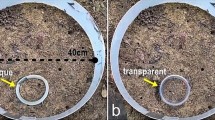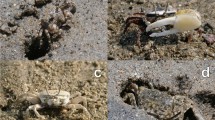Abstract
The soldier crab appears in great numbers and feeds while wandering during daytime low tide. When they see an approaching object, they screw themselves into the sand. The mechanism of formation of mass wandering has not been clarified. In this study, to investigate if the soldier crabs use visual images of neighbors as a stimulus for wandering, dummy crabs were presented to crabs. In the experiments, one, two, four, or eight dummies were placed in a circle on a sand arena. Each crab was placed in the center of the arena and observed whether it burrowed into the sand or wandered. The proportions of wandering individuals in each experimental treatment were compared with the expected value. Significantly more crabs were wanderers when only two and four dummies were present. This result suggests that soldier crabs chose burrowing or wandering depending on visual image of the distribution of the neighbors.






Similar content being viewed by others
References
Takeda M (1978) Soldier crabs from Australia and Japan. Bull Natl Mus Nat Sci 4:31–38
Yamaguchi T (1976) A preliminary report on the ecology of the sand bubbler crab, Mictyris longicarpus Latreille (in Japanese). Benthos Res 11(12):1–13
Nakasone Y, Akamine T (1981) The reproduction cycle and young crab’s growth of the soldier crab Mictyris brevidactylus Stimpson, 1858 (in Japanese). Biol Mag Okinawa 19:17–23
Hartnoll RG (1973) Factors affecting the distribution and behavior of the crab Dotilla fenestrata on East African shores. Estuar Coast Mar Sc 1:137–152
Wada K (1981) Wandering in Scopimera globosa (Crustacea: Ocypodidae). Publ Seto Mar Biol Lab 26:447–454
Christy JH, Salmon M (1984) Ecology and evolution of mating system of fiddler crabs (genus Uca). Biol. Rev. 59:483–509
Henmi Y (1984) The description of wandering behavior and its occurrence varying in different tidal areas in Macrophthalmus japonicus (De Haan) (Crustacea: Ocypodidae). J Exp Mar Biol Ecol 84:211–224
Koga T (1995) Movements between microhabitats depending on reproduction and life history in the sand-bubbler crab Scopimera globose. Mar Ecol Prog Ser 117:65–74
Takeda S, Murai M (2004) Microhabitat use by the soldier crab Mictyris brevidactylus (Brachyura: Mictyridae): interchangeability of surface and subsurface feeding through burrow structure alteration. J Crustacean Biol 24:327–339
Murai M, Goshima S, Nakasone Y (1983) Adaptive droving behavior observed in the fiddler crab Uca vocans. Mar Biol 76:159–164
Nalbach HO (1990) Discontinuous turning reaction during escape in soldier crabs. J Exp Biol 148:482–487
Zeil J, Nalbach G, Nalbach HO (1986) Eyes, eye stalks and the visual world of semi-terrestrial crabs. J Comp Physiol A 159:801–811
Nalbach HO, Nalbach G (1987) Distribution of optokinetic sensitivity over the eye of crabs: its relation to habitat and possible role in flow-field analysis. J Comp Physiol A 160:127–135
Nalbach HO, Nalbach G, Forzin L (1989) Visual control of eye-stalk orientation in crabs: vertical optokinetics, visual fixation of the horizon, and eye design. J Comp Physiol A 165:577–587
Cameron AM (1966) Some aspects of the behavior of the soldier crab, Mictyris longicarpus. Pac Sci 20:224–234
Kraus HJ, Tautz J (1981) Visual distance-keeping in the soldier crab, Mictyris platycheles Latreille (Grapsoidea: Mictyridae): a field study. Mar Behav Physiol 6:123–133
Kelemec J (1979) Effect of temperature on the emergence from burrows of the soldier crab, Mictyris longicarpus. Aust J Mar Freshw Res 30:463–468
Tinbergen N (1963) On aims and methods in ethology. Zeitschrift f\(\ddot{u}\)r Tierpsychologie 20:410–433
Robertson JR, Bancroft K, Vermeer G, Plaisier K (1980) Experimental studies on the foraging behavior of the sand fiddler crab Uca pugilator (Bosc, 1902). J Exp Mar Biol Ecol 44:67–83
Gherardi F, Russo S, Lazzara L (2002) The function of wandering in the sand-bubbler crab, Dotilla fenestrate. J Crustacean Biol 22:521–531
Calvert WH, Hedrick LE, Brower LP (1979) Mortality of the monarch butterfly, Danaus plexippus: avian predation at the five overwintering sites in Mexico. Science 204:847–851
Author information
Authors and Affiliations
Corresponding author
Additional information
This work was presented in part at the 1st International Symposium on Swarm Behavior and Bio-Inspired Robotics, Kyoto, Japan, October 28–30, 2015.
About this article
Cite this article
Moriyama, T., Mashiko, Ji., Matsui, T. et al. Visual image of neighbors to elicit wandering behavior in the soldier crab. Artif Life Robotics 21, 247–252 (2016). https://doi.org/10.1007/s10015-016-0292-7
Received:
Accepted:
Published:
Issue Date:
DOI: https://doi.org/10.1007/s10015-016-0292-7




